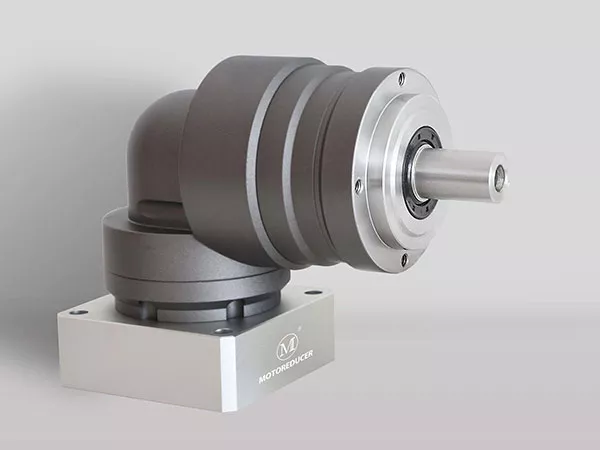1. Clarify Application Requirements and Operating Conditions
- Determine Load Type:
- Torque Requirements: Calculate the maximum torque during operation (including starting and continuous torque) to ensure the reducer’s rated torque is ≥ actual load torque. For instance, robotic joints require high precision and low torque, while heavy machinery may need thousands of Nm of torque.
- Load Nature: Differentiate between constant torque loads (e.g., conveyor belts), impact loads (e.g., machine tool start-stop cycles), and fluctuating loads (e.g., vibrating equipment). Select reducers with appropriate strength (e.g., reinforced gears or wear-resistant materials).
- Speed and Gear Ratio:
- Input Speed: Match with the motor’s speed (e.g., servo motors typically operate at 3000rpm), and avoid exceeding the reducer’s maximum input speed limit (usually between 3000–6000rpm).
- Gear Ratio Calculation: Based on the required output speed, calculate the gear ratio using the formula: Gear Ratio = Input Speed / Output Speed. For example, with a motor speed of 3000rpm and an output speed of 100rpm, the gear ratio would be 30:1.
- Accuracy Requirements:
- Backlash: Refers to the free play in the gear mesh, measured in arc minutes. High-precision applications (e.g., CNC machines, robots) require reducers with a backlash ≤ 5 arc minutes, while standard industrial applications may allow a range of 10-15 arc minutes.
- Positioning and Repetition Accuracy: For high-precision equipment, pay attention to the reducer’s transmission error and stability, such as with laser cutting machines, where the error must be ≤ 1 arc minute.
2. Core Performance Parameter Comparison
| Parameter | Key Indicators | Selection Advice |
|---|---|---|
| Torque Capacity | Rated torque, maximum peak torque (short-term overload capacity) | Allow a 20%-30% safety margin to avoid extended full-load operation, which can shorten the lifespan. |
| Transmission Efficiency | Gear meshing efficiency (typically 90%-97%, slightly lower with more planetary stages) | Prioritize high-efficiency models for long-term operation to reduce energy consumption and heat generation. |
| Noise Level | Operational noise (dB, usually ≤ 65dB for low noise) | For medical and precision instrument applications, select low-noise models (e.g., bevel gears produce less noise than straight gears). |
| Lifespan & Reliability | Rated lifespan (hours), fatigue strength, protection level (e.g., IP65 for dust and water resistance) | Choose higher protection levels for harsh environments (dust, moisture), and ensure the gear material (e.g., carburized steel) is suitable for heavy loads. |
| Installation Method | Flange, shaft, or foot mounting, ensuring compatibility with the motor interface and equipment structure | Ensure that installation dimensions are compatible to avoid operational issues due to installation errors. |
3. Consider Operating Environment and Maintenance
- Environmental Conditions:
- Temperature and Cooling: For high-temperature environments (e.g., ovens, metallurgical equipment), choose reducers with high-temperature lubricants or cooling designs. In low-temperature environments, consider the flowability of lubricants (e.g., use low-viscosity oils).
- Dust and Protection: For dusty environments (e.g., mining, woodworking machinery), opt for fully enclosed structures (IP67) to prevent foreign particles from damaging the gears.
- Maintenance Convenience:
- Lubrication Cycle: Some reducers support long-life lubrication (maintenance-free) using synthetic oils or self-lubricating materials. For models requiring periodic maintenance, ensure oil filler holes are conveniently positioned for easy oil change.
- After-Sales Service: Choose brands with local service networks (e.g., Guomao, Zhongdali) for fast response in case of failure repairs and parts replacement.
4. Selection Steps Summary
- List Operating Parameters: Torque, speed, accuracy, environmental conditions, etc.
- Filter Brands and Models: Based on budget and precision requirements, choose 2-3 brands from corresponding series (e.g., Motovario MAF series, Inovance MD500 series).
- Verify Installation Dimensions: Confirm the reducer matches the motor and equipment interface (e.g., flange hole diameter, shaft diameter, center distance).
- Testing and Verification: If possible, perform no-load and load tests to check noise, temperature rise, and operational stability.
- Sign Contract and After-Sales: Clarify warranty terms (usually 1-2 years), return/exchange policies, and technical support agreements.
5. Common Issues and Pitfalls to Avoid
- Q: How to calculate actual torque? Formula: Torque (N·m) = 9550 × Motor Power (kW) / Speed (rpm) × Gear Ratio × Efficiency. Example: For a 1kW motor running at 3000rpm, with a 10:1 gear ratio and 95% efficiency, the output torque ≈ 9550 × 1 / (3000 × 10 × 0.95) ≈ 3.37 N·m.
- Pitfall: Ensure the reducer’s “instantaneous maximum torque” is suitable for starting impact loads to prevent frequent overloads that could lead to gear breakage.

